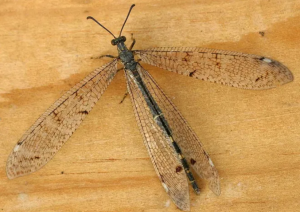
Doodlebugs create pitfall traps in dry, sandy areas to lure unsuspecting ants. Their “doodles” in the sand are visible as well. Photo credit: Carrie Stevenson, UF IFAS Extension
It’s been years since I ran across doodlebugs. But when I saw a stretch of their pitfall traps at a campsite near Coldwater Creek in MIlton, I knew it was time to write about them. Lore says their silly name came from Southern kids like me, who watched the larvae drag their bodies around in the sand, leaving patterns (or doodles) etched behind them. These insects have long fascinated children and creative writers, with some of my favorite authors–Twain, Steinbeck, Thoreau–referencing doodlebugs in their books.
Doodlebugs, aka ant lions (Myrmeleon immaculatus—although we have 22 species in Florida!), are fascinating little insects that prey upon ants by creating slippery funnels in the sand. They wait underground below the funnel opening as unsuspecting ants march along the surface and slide down in the ensuing “mini avalanche.” If an ant or other prey item manages to get away, the ant lion can sling sand at it to try and knock it back down into the pit. Doodlebug larvae are the stuff of cartoon nightmares. They possess a pair of giant clawed mandibles, capable of grabbing and injecting prey with a toxin. The poison paralyzes the victim and contains digestive fluids which liquify its insides. At this point, the ant lion goes in for the kill by sucking out the prey’s juices through its deadly mandibles.

An adult doodlebug/ant lion bears no resemblance to its larval stage! Photo credit: Campbell Vaughn, UGA
Ant lions may stay in this frightening larval stage for up to 3 years. After this they undergo metamorphosis, spending 3 weeks in a cocoon. As adults, their transformation is dramatic; they are closely related to lacewings and dobsonflies, with long, thin bodies and large translucent wings.
As kids, we always found doodlebugs under my best friend’s treehouse. In Milton, they were in a sandy area beneath a cabin roof overhang. These dry, protected sand areas are their preferred habitat and the best place to find them. We used to stick pine needles down into the openings, and watch as a flutter of insect mouthparts tried to grab it from us. Because of their fascinating life cycle and dramatic hunting technique, doodlebugs can be a captivating addition to a science classroom. In fact, there’s a reference to doodlebugs on the NASA website, due to an Apollo 16 astronaut’s mention of them. When landing on the moon, the craters reminded Charlie Duke of doodlebug pits, prompting him to recite an old children’s rhyme, “Doodlebug, doodlebug, are you at home?”
- Wax Myrtle–a Native Evergreen - December 26, 2025
- Yucca–A Tough and Versatile Native Plant - November 26, 2025
- Blazing Star - November 6, 2025


